Bloat in Newts
By Ed Kowalski
"Bloat" is a very common disease symptom in imported newts, particularly in newly imported Cynops sp. Many people mistake "bloat" as a disease as opposed to a symptom. Bloat is a symptom of a number of potential diseases. Bloat can be indicative of bacterial infections (e.g. "red leg"), and of kidney damage from a variety of sources. Several less-threatening conditions can present bloat-like symptoms. These include constipation, egg retention and ovulation. However, these conditions do not present in the same manner. Constipation, egg retention and ovulation usually only involve the abdominal region close to the cloaca or, at most, the torso of the affected caudate. Bloat on the other hand, will usually involve the torso and neck at a minimum, and the entire body and limbs in severe cases.
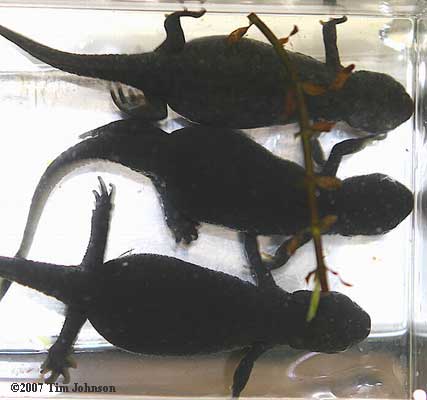
These healthy Cynops orientalis are gravid (carrying eggs). The abdomen is enlarged, but only the central and lower abdomen is affected.
Without performing a number of tests on the newts, the actual cause in each case will remain a mystery. However, if one were to take an educated guess based on the treatment of these newts prior to arrival in the hands of the keeper, then the leading cause would probably be kidney damage. The most common cause of kidney damage in the newts would be dehydration or heat stress sometime in the period after collection but before the newt ended up in the herpetoculturist's collection. Kidney damage can cause the symptoms of bloat days to weeks following the cause of the damage as the kidneys slowly shut down (Wright, 1996). Kidney damage would explain why newly-imported newts often come down with "bloat", do not respond to antibiotic treatment, and do not pass the condition on to the other amphibians in the enclosure (as would be expected for a strictly bacterial infection). This would also explain why there are some spontaneous remissions of bloat (the damage was not so extensive the animal could not recover on its own, or the causative factor was starvation). In the case of starvation, the absorbtion of the muscle tissues causes the newt to retain fluids causing another type of bloat. In these cases, the herpetoculturist should not immediately feed the animal as much as it will eat. Heavy feedings can cause the animal to go into shock and die. As an alternative, feed very small meals every day for a week and then slowly begin to increase the quantity of food offered. After several weeks, the frequency can also be reduced until the caudate is on a regular feeding schedule. This will allow the animal to adjust to increased food without causing the possibility of shock.
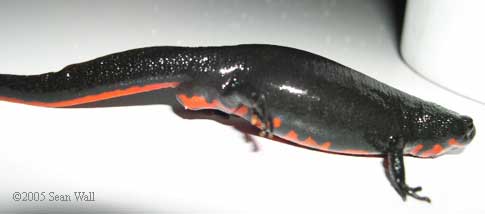
A rapidly-developing case of bloat in a Cynops orientalis. Features of bloat: stretched skin, swollen throat, and swollen cloaca.
In some cases, the legs and tail may also be swollen, but not always.
Many newt owners attempt to treat bloat with over the counter medications from pet stores. In the majority of these cases, the antibiotics may do more harm than good. The only currently available over the counter fish antibiotic that is commonly used for the treatment of amphibians is tetracycline. However, the majority of common amphibian pathogenic bacteria are resistant to tetracycline (Wright, 1996). Hexamit contains metronidazole, an antiprotozoal medication that has some specificity against anaerobic organisms. However, metronidazole should only be used as an oral treatment for anaerobic infections; it may be fatal if overdosed. Most of the other common fish medications are also ineffective in treatment of amphibian disease due to the advent of widespread resistance and the fact that amphibian skin is only semipermeable at best to the antibiotic. This means that the antibiotic may not be able to reach therapeutic levels in the caudate's tissues. This only hastens the spread of antibiotic resistance. Many of the antibiotics that treat amphibian bacterial diseases are also potentially damaging to the kidneys if used improperly. This could make a case of mild kidney damage into an irreversible condition. The only way to determine if there is a bacterial infection or some other agent causing the bloat would be for a veterinarian to draw some fluid and conduct a bacterial culture. If positive, the culture can also be used to determine the sensitivity to antibiotics of that strain of bacteria, thus allowing an effective course of antibiotics. Additionally, a veterinarian may also be able to supply an appropriate supportive fluid therapy, such as by being soaked in amphibian Ringer's solution*. Also, treatment of the enclosure with antibiotics may disrupt the biological filtration in the aquarium. The disruption of the biological filter will result in a subsequent rise of the ammonia and nitrite. Ammonia has been well documented to sicken and kill amphibians. The effects of nitrite on amphibians have not been as well documented, but it can cause fish mortality. In any case, poor water quality can also potentially cause bloat by interfering with the newt's ability to osmoregulate.
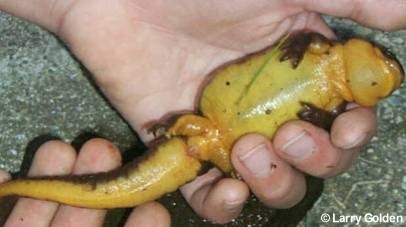 An extreme case of bloat in a wild-caught Taricha sp. |
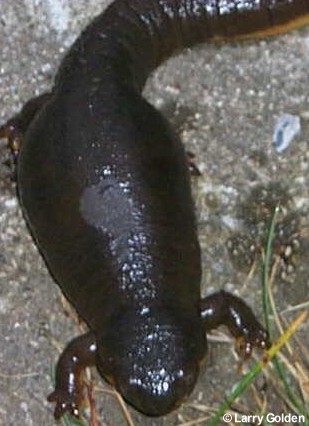 |
If a newt comes down with bloat, the newt should be removed to an isolation enclosure. This will prevent infecting other newts if an infectious agent causes the disease. The newt should remain in the isolation enclosure until the newt is cured or dies. The discovery of "bloat" in a newt will mean that the herpetoculturist will have to make some crucial decisions as to how to react to the symptom. The decision will need to be made as to whether to seek medical assistance. If the disease is of bacterial origin, then speed may be crucial as some infections may rapidly cause the death of the animal (for example Aeromonas, a.k.a. "red leg") and potentially infect the other amphibians in the same enclosure. Medical assistance will allow access to truly effective antibiotics and a potential diagnosis. However, the downside is that this may be an incurable condition (kidney damage) which may cause a slow and lingering death. In the case of severe kidney damage, the herpetoculturist may need to weigh the merits of euthanasia. Each herpetoculturist will need to weigh each of these factors for themselves on a case by case basis.
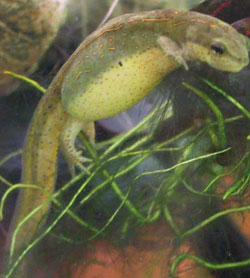 A slowly-developing case of bloat in a female Notophthalmus viridescens, which had been in captivity for many years. At this stage, the animal looks fat or gravid. |
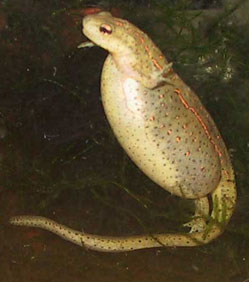 The same animal several months later. At this point, the newt is clearly abnormal. Unlike the more quickly-developing cases, the bloat did not affect the neck or limbs. It was euthanized shortly after this photo was taken. At autopsy, the body cavity was found to be filled with clear fluid. |
References:
Wright, KM, 1996. Amphibian Medicine and Husbandry, In Reptile Medicine and Surgery, Mader, Douglas R., ed. Philadelphia: W.B. Saunders.
Wright, KM and Whitaker, BR. 2001. Amphibian Medicine and Captive Husbandry. Malabar: Krieger Publishing.
*Amphibian Ringer's Solution
Amphibian Ringer's is made by thoroughly mixing the following in one liter of distilled/reverse osmosis or deionized water:
Sodium chloride (NaCl) 6.6 grams
Potassium chloride (KCl) 0.15 grams
Calcium chloride (CaCl2) 0.15 grams
Sodium bicarbonate (NaHCO3) 0.2 grams
The salts will need to be thoroughly stirred to ensure that all salts are well dissolved.
Last edited September 5, 2002
©2001 Ed Kowalski
